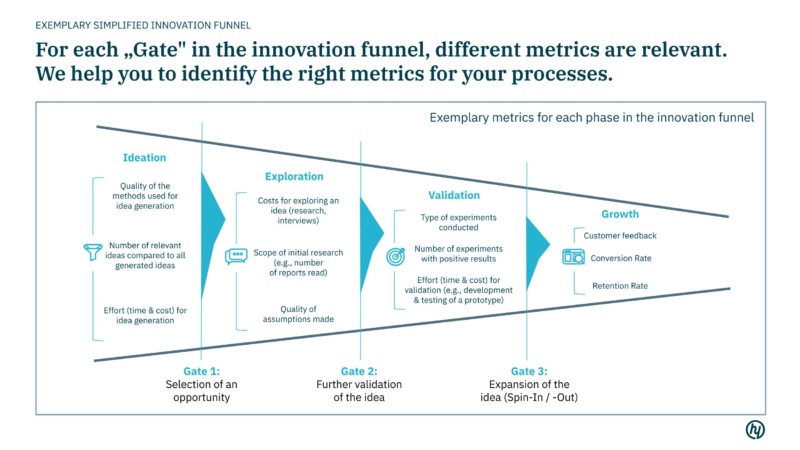If you can measure it, you can manage it: How Performance Tracking of Innovation Units Works

Systematic data collection, analysis, and management are increasingly being established in various corporate sectors to make performance transparent within relevant metrics and to make decisions based on data.
This development does not spare innovation units. Numerous articles and research now discuss the value of internal innovation units or external “innovation labs” for corporations. A common consensus is that they often fail due to unclear objectives, excessive corporate politics, and a lack of added value for the core business, reflected in a lack of directly measurable revenues. According to our “Corporate Innovation Report 2023”, although almost all of the 100 companies surveyed have established innovation teams, only 59 % believe that the current structures are sufficient for success, partly due to a lack of alignment. This underscores the need for clear goals, including metrics linked to the core business. Clear performance tracking can help preventively before justification discussions with management become necessary to justify the value of the innovation unit.
In this article, we will show you ways to make the value of innovations measurable, thus pushing discussions about the right to exist into the background – following the motto: “If you can measure it, you can manage it.”
Overwhelm with Data
The adapted phrase “You can’t manage what you can’t measure” is attributed to management expert Peter Drucker and statistician William Edwards Deming. Although this quote is not universally positively received due to its one-dimensional view that data analysis is the key to success, it underscores an important aspect of modern management.
In an era of vast amounts of information, prepared data in the form of metrics provides the opportunity to focus on the essentials, create narratives, and make informed decisions. However, being overwhelmed by the flood of data often leads to avoiding careful data preparation.
Metrics as a Guide for Achieving Goals
The process for innovation areas typically follows a similar pattern: The process of defining metrics ideally begins with the company vision, followed by translation by the innovation unit into a suitable growth strategy, coordinated with relevant stakeholders. Then, relevant goals are set, which are finally made measurable through metrics.
An example to illustrate: The vision of an automotive manufacturer is to make e-mobility accessible to everyone in Germany by 2028. The innovation unit develops appropriate goals and activities, such as developing e-mobility solutions in cities. A specific goal could be to support the expansion of the charging infrastructure through partnerships with startups to make e-vehicles more attractive in urban areas. It is advisable to think in terms of desired changes (“Outcomes”) rather than fixed results (“Outputs”). Metrics provide guidance to review these goals, such as the number of identified startups or the rate of realized partnerships. When setting metrics, it is advisable to consider three aspects:
- Metrics should initially be adaptable to promote a learning/experience-oriented approach to achieving goals.
- Ambitious goals with metrics can motivate but also frustrate if they are unrealistic. A realistic framework that balances challenges and feasibility can help here.
- In addition to quantitative metrics, qualitative metrics, such as interviews, can provide important insights as they capture nuances that purely quantitative metrics might overlook.
The Importance of Performance Tracking in Innovation Units
Metrics serve as a reporting tool for management and as guidance to regularly check which innovation activities are performing less well or as expected compared to the goal. Especially in the field of innovation, where the perception of “innovation theatre” can quickly arise, this can help demonstrate success to critics through numbers.
In terms of methodology, many companies use OKR (Objectives and Key Results) for goal development to measure progress at specific time intervals. For innovation teams, there are numerous resources, such as Dan Toma’s measurement methods, which focus mainly on the evaluation of ideas. If a clear strategy is lacking, Verne Harnish’s 7 Strata method can help develop a strategy, including metrics, in seven steps. Ultimately, the choice of measurement methodology should fit the company and the nature of the innovation unit. At hy, we draw on a broad range of methods to recommend the most suitable approach for your company.
Metrics Work with the Right Processes and Structures
At hy, we support companies in identifying and implementing appropriate performance tracking. To do this, we follow a four-step process for creating or optimizing innovation metrics. We focus specifically on individual aspects such as strategy, innovation processes and structures, as well as the capabilities of the innovation unit’s team, or we incorporate all aspects simultaneously – depending on the need.

- Understanding the Status Quo: First, we capture the existing metrics of the innovation unit, which serve as a basis, and determine which existing metrics future performance tracking can build upon.
- Auditing the Current State: Through interviews and surveys with key stakeholders, we analyze: a. the given goals, b. the expectations of the innovation department, and c. how the requested or existing innovation activities can be represented in numbers. For the new metrics, we identify new, optimized communication and decision-making processes using value stream analyses.
- Defining the New Performance Tracking: The selection of evaluation methods (such as OKRs) and the communication of the new metrics, e.g., in a digital dashboard with various matrices or a weekly data review newsletter, is crucial. We advise on the appropriate selection for visualization as well as implementation.
- Optimizing Structures and Processes: If relevant structures and processes are missing to measure metrics at all, hy also assists in building these foundations, e.g., by establishing an innovation funnel.

Even though innovation units often use unconventional metrics to measure success, the impact on revenue remains the decisive metric for management. Our hy team, consisting of experts with many years of experience in building and leading successful innovation units, possesses the necessary knowledge to develop the appropriate metrics and tools together with you.
Be aware of the Cobra Effect in Performance Tracking
Metrics can lead to false incentives: The Cobra Effect occurs when solutions have undesirable consequences due to incorrect incentives. In performance tracking, this can lead to innovation units focusing too much on quantitative goals and losing sight of the actual added value. It is important to prioritize the benefits for end customers and the company. By involving relevant stakeholders and regularly reviewing the metrics, their meaningfulness can be ensured.
Success Guaranteed (Visible)
Performance tracking is essential to make the success of innovation units visible. It helps clearly demonstrate the value contribution with metrics and ensure alignment with the core business and the company’s vision. Summarized benefits in one sentence: 1. they improve communication with and reporting to relevant stakeholders, 2. they are essential in focusing and 3. optimizing innovation activities.
We at hy offer comprehensive support in identifying and implementing performance tracking and can help you with the appropriate metrics and tools to make the success of your innovation units visible.
For those seeking additional success factors for innovation units beyond performance tracking, these can be found in our Corporate Innovation Report 2023.


